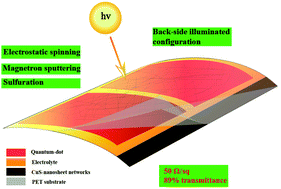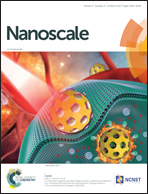Highly flexible, transparent and conducting CuS-nanosheet networks for flexible quantum-dot solar cells†
Abstract
The rapid development of modern electronics has given rise to a higher demand for flexible and wearable energy sources. Flexible transparent conducting electrodes (TCEs) are one of the essential components of flexible/wearable thin-film solar cells (SCs). In this regard, we present highly transparent and conducting CuS-nanosheet (NS) networks with an optimized sheet resistance (Rs) as low as 50 Ω sq−1 at 85% transmittance as a counter electrode (CE) for flexible quantum-dot solar cells (QDSCs). The CuS NS network electrode exhibits remarkable mechanical flexibility under bending tests compared to traditional ITO/plastic substrates and sputtered CuS films. Herein, CuS NS networks not only served as conducting films for collecting electrons from the external circuit, but also served as superior catalysts for reducing polysulfide (S2−/Sx2−) electrolytes. A power conversion efficiency (PCE) up to 3.25% was achieved for the QDSCs employing CuS NS networks as CEs, which was much higher than those of the devices based on Pt networks and sputtered CuS films. We believe that such CuS network TCEs with high flexibility, transparency, conductivity and catalytic activity could be widely used in making wearable electronic products.



 Please wait while we load your content...
Please wait while we load your content...